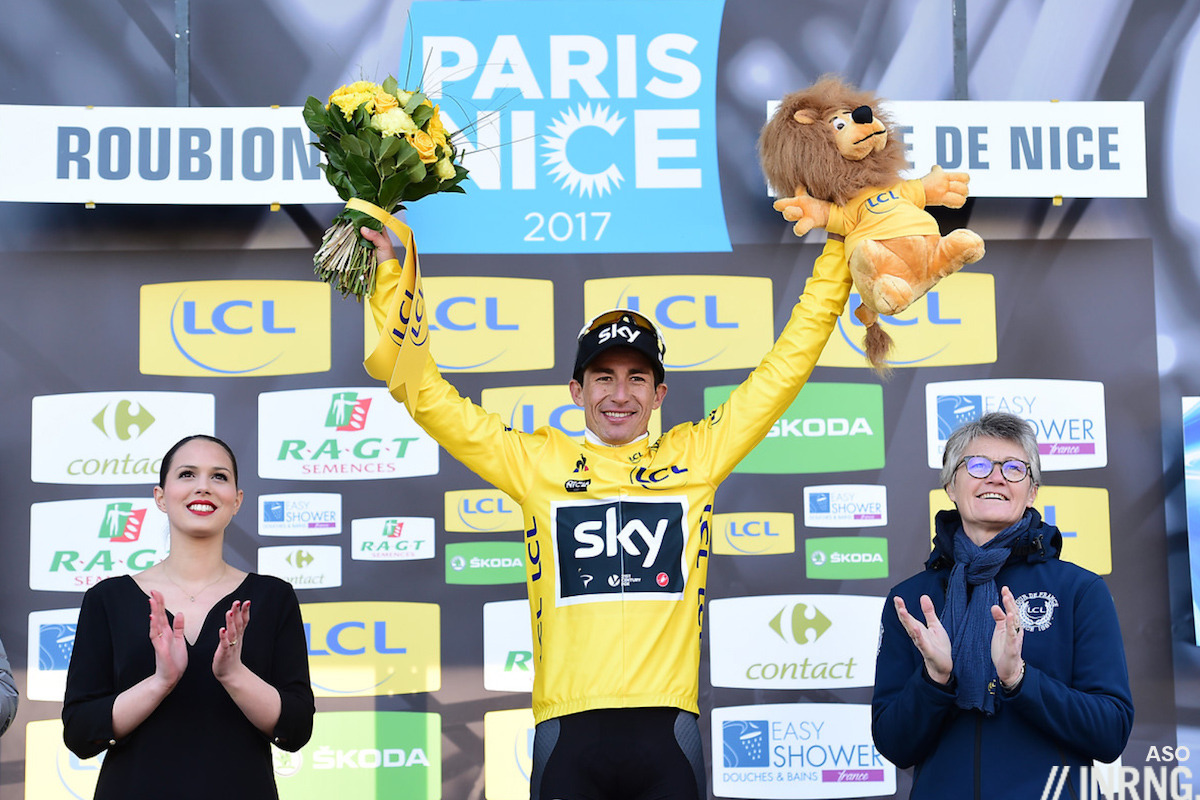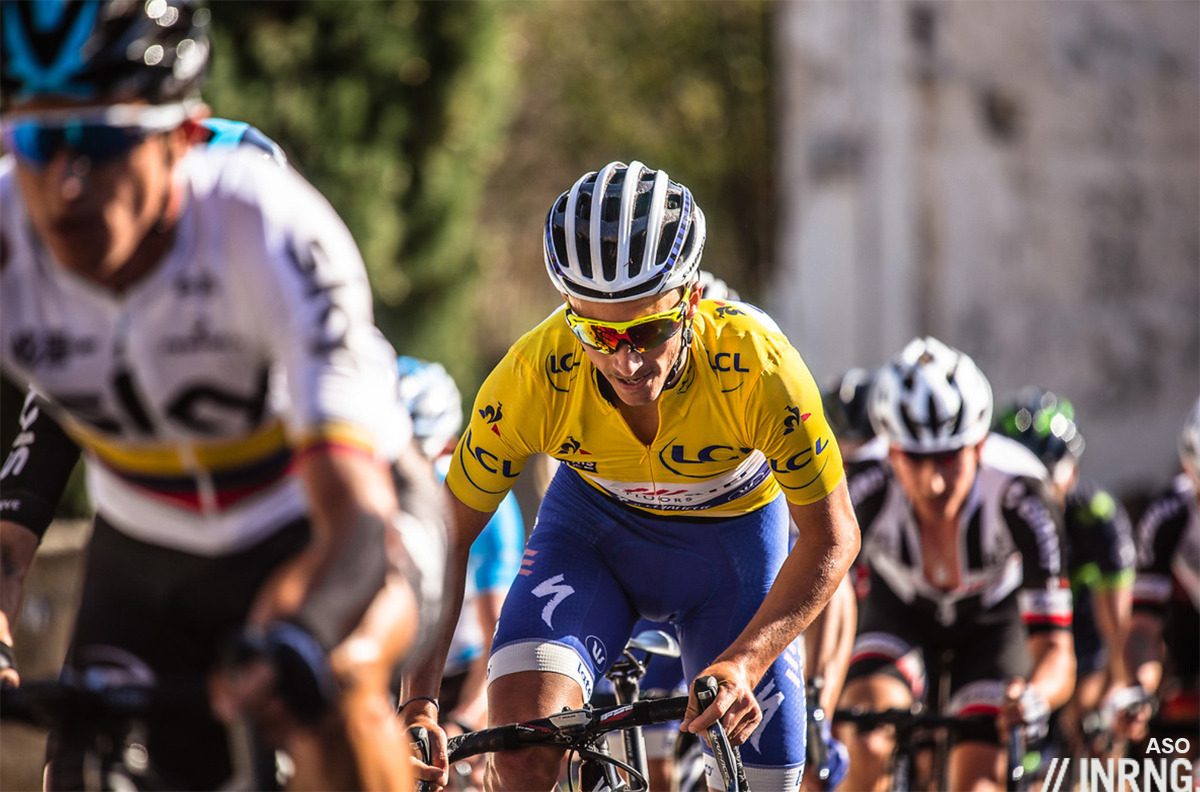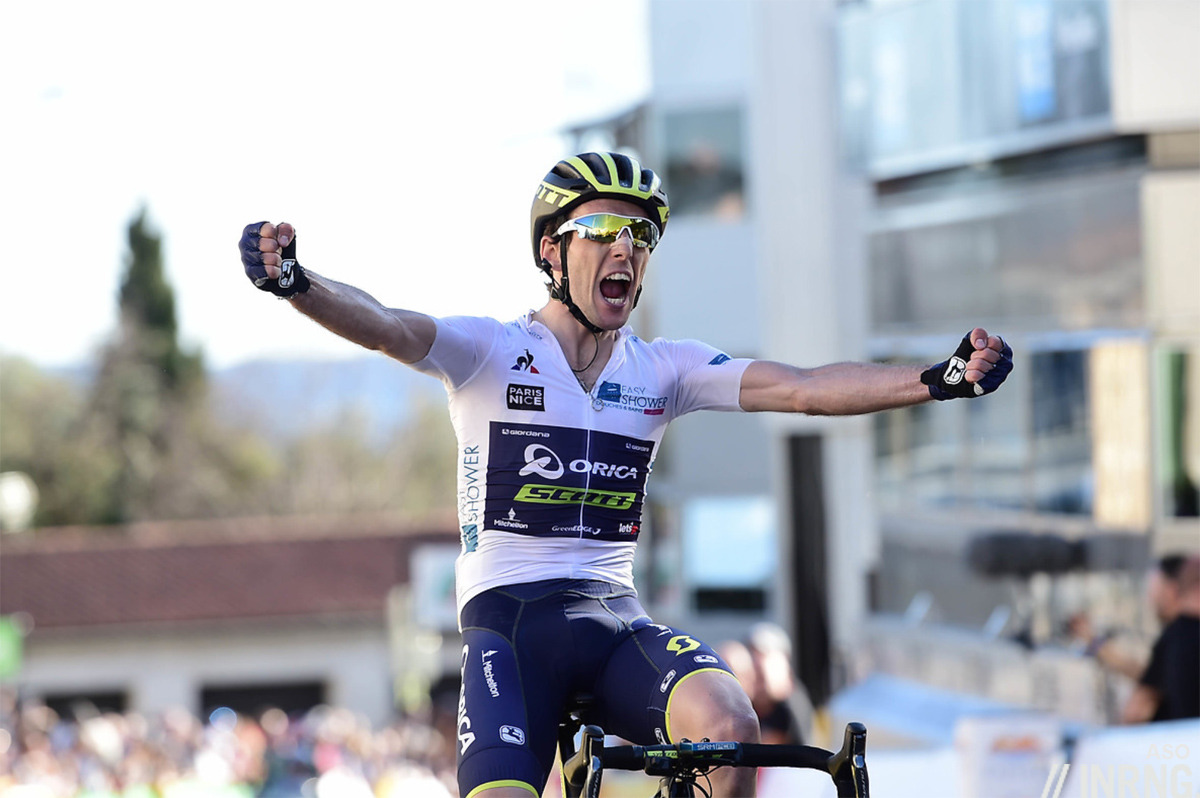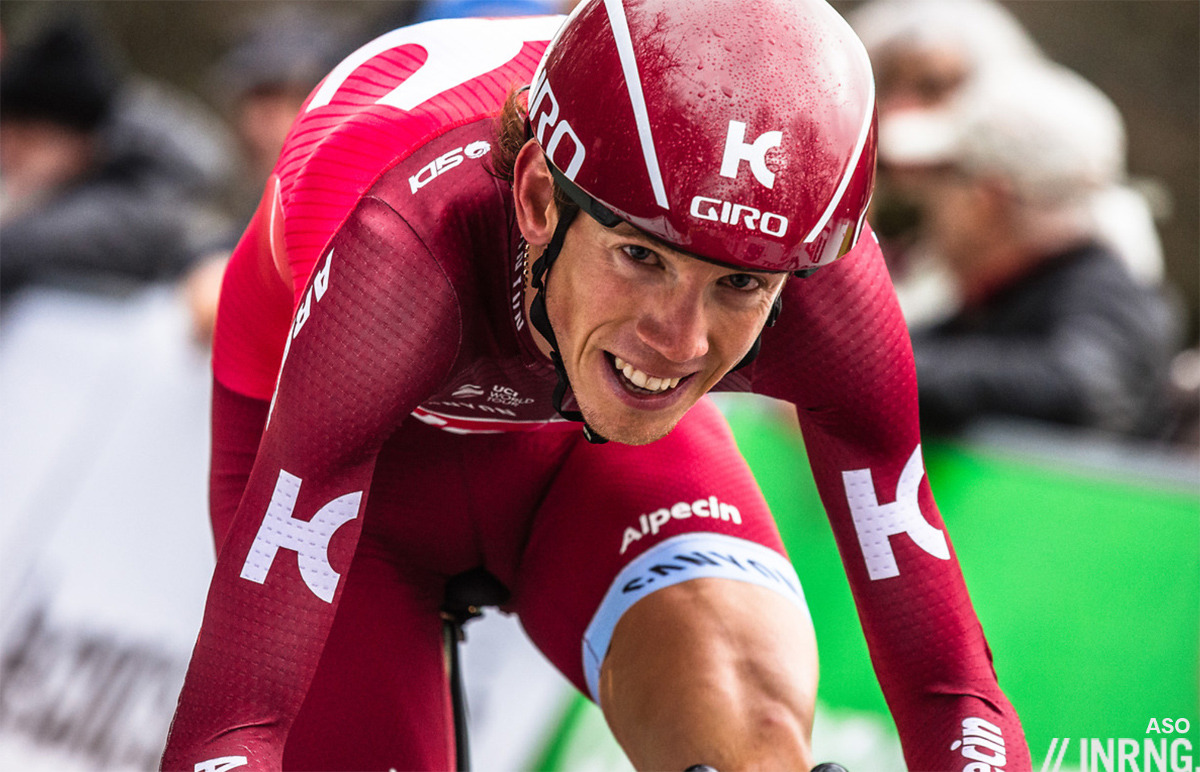The first major stage race of the year starts on Sunday outside Paris and makes its way to Nice. It’s the “Race to the Sun, with the emphasis on the preposition “to” as before the riders feel the sun on their backs and pedal past palm trees there’s plenty of tricky terrain to cover.
There will be daily stage previews here and ahead of the race here’s a look at who might win the race overall.
Route summary

In order to know who might win the race let’s take a quick look at the roads to Nice. There are time bonuses for the seven road race stages with 3-2-1 seconds at the intermediate sprints and 10-6-4 at the finish line.
- Stage 1 has an uphill finish including cobbles where the GC contenders and the fittest sprinters will scrap for the result and time bonuses
- Stage 2 is as flat as a crêpe but could be risky if the wind gets up, for now the forecast looks calm
- Stage 3 has a finishing circuit with a climb, nothing steep but riders need to be alert
- Stage 4 is a crucial time trial, uphill from the start and then a descent before flicking up a steep and twisty climb with a reciprocal descent and then a fast run to the football stadium in Saint Etienne
- Stage 5 is hilly but better suited to a breakaway than GC action while Stage 6 offers both, hard terrain for a breakaway but the GC contenders will scrap over the steep roads in the finish
- Stage 7 is the Queen Stage thanks to the ski station finish at La Colmiane, 16km at an average of 6.2% but that’s the mean and the typical or mode slope is more like 7%
- Stage 8 is the Nice-Nice loop, just 110km but packed with climbing
Overall this is a hard course with set-piece moments in the time trial and the finish on Stage 7, straight tests of power and form while Stages 6 and 8 have several traps and tricks.
The Contenders

Team Sky have won five of the last six editions of this race and if the past doesn’t always predict the future, their squad gives us plenty of clues. Last year’s winner Sergio Henao looks capable again but Wout Poels seems just as likely and brings more assurance for the time trial stage. David de la Cruz is another contender too, he won the final stage last year and is in great form having won the Ruta Del Sol’s time trial but has been limited in the high mountains, La Colmiane could be his downfall.
Astana seem to be over their funding crisis… for now. They’ve had a strong start to the season and bring Luis Leon Sanchez and Jacob Fuglsang. Both have a chance but Fuglsang is an infrequent winner – his win in the Dauphiné last summer was his first ever World Tour victory – while Sanchez is a regular winner of stages but hasn’t won the GC in anything since 2010, even if he did win this race back in 2009.

Julian Alaphilippe wore yellow last year after winning the time trial but lost it on the ski station summit finish. He’ll be in the mix again given his versatility and form, he was duelling with Valverde last weekend on the slopes of the Jebel Hafeet but can he keep his cool? Part of the fun is watching his temperamental style but this makes a result harder. He doesn’t have much support with a team built around sprinter Elia Viviani which means taking on Team Sky won’t be easy.
Tim Wellens isn’t normally a stage race pick, when he’s won the GC in races before it’s been thanks to audacious, against-the-odds attacks. His recent win in the Ruta del Sol was the opposite, he matched the best on the long climbs, on the short climbs and did a great time trial. This year’s course suits him and he’s declared the race a target. It’ll be fun watching him try.
Tejay van Garderen seems in good shape and this is a course that suits him. He’s been written off a stage race contender, went stage hunting in the Giro and dutifully slogged his way around the Vuelta and is now making noises about contending for stage races again and leads BMC Racing.
Gorka Izagirre had a good Tour of Oman and both he and his brother Ion Izagirre are outsiders. They’re unlikely to win by triumphing in the time trial and mastering the mountain stage but will aim to stay in contention until the final stage.

Mitchelton-Scott bring the tandem of Esteban Chaves and Simon Yates. Next week’s route has only one big summit finish and so the time trial becomes all important and it’s not his best point and besides having won the Herald Sun Tour his form is unknown and he’s probably not on the boil. Normally Simon Yates is good at poaching stages and time bonuses too – he won a stage last year – but he was out of the running in Abu Dhabi last week suggesting he’ll suffer on La Colmiane. They’re backed by a strong team.
Tony Gallopin says Paris-Nice is a big target for him and he’s in shape having won the Etoile de Bessèges. However he’s the sort of rider who enjoys this race and is able to place in the top-10 overall but is an infrequent winner, especially of World Tour races let alone the GC so as confident as he sounds it’ll be a big ask. Alexis Vuillermoz brings more options for stage wins and support.
Bauke Mollema can fly under the media radar sometimes, he’s now Trek-Segafredo’s stage race captain and is good on punchy climbs and short time trials, the win would be a surprise but a podium is within range. Dan Martin can lose minutes in a time trial but don’t count him out from the podium, he’s a crafty climber with a good sprint; his UAE Emirates team mate Rui Costa looks in shape too but both seem suited for a stage win over the yellow jersey. Sam Oomen leads Team Sunweb, watch to see what he can do with the young rider jersey an obvious goal as he rides on a team in service of sprinters. Movistar’s Marc Soler is another to watch, especially for the white jersey. He’s one of Spain’s big hopes for the future and the recent past shows he’s in form with a podium finish in the Ruta del Sol. Team mate Richard Carapaz is another promising rider. Cofidis have twin aims with Nacer Bouhanni for the sprints and Jesus Herrada for a high GC place.

Katusha’s Ilnur Zakarin made the podium in the Vuelta and has won the Tour de Romandie which gives him pedigree for a race like this. However his form in Abu Dhabi looked off, a blip or reality? Direct Energie’s Lilian Calmejane won last weekend, he got away with two Quick Step riders and blew them away. His no-prisoners style of racing could deliver a stage win but the GC seems a big ask. Finally Warren Barguil (Fortuneo-Samsic) has all but ruled himself out of the race saying he’s not yet in shape and unless he’s bluffing or just very modest, he’s building up for the Ardennes classics before taking aim at the Tour de France.
| Wout Poels | |
| Sergio Henao, Julian Alaphilippe | |
| Tim Wellens, Tejay van Garderen | |
| L-L Sanchez, Jacob Fuglsang, Bauke Mollema, Gorka Izagirre | |
| Martin, Yates, Zakarin, De la Cruz Gallopin, Soler |


The Pa-Ni has been really struggling to attract a top-level field in the last decade (but the process started along with the years 2000s), probably also due to the growing pressure by Ti-Ad, which in the same years switched its focus from Sanremo prep suited for Classics champions to relevant goal in itself for GT (…not just “stage race”!) specialists.
At Pa-Ni they’ve tended to have great racing anyway… at least, when Contador was around, with several other editions ending up being a bit dull.
However, I like their often creative approach to course design. And, luckily, they’re ASO, otherwise they might be declining. Instead, they’re always granted great media support which keeps them always very alive and kicking, as it should be for a race with such a glorious tradition.
Every single season, I love watching as the riders have to choose where they’ll ride. I know that most “cycling reformers” hate the overlapping and not having each and every champion in the mix, but to me it’s just as good to have two great races and all the debate, strategy, imagination about who’s racing where.
+1 on your last point. You need to look at the season as event, the races are the tapestry it’s made from. How riders build towards their targets differently only adds to the narrative, and spectacle when they do go head to head
Watching pro cycling races is a paradox, due to the doping that exists in the sport. The riders’ performances always arouse suspicion yet with the Strada yesterday and the Paris-Nice all this coming week (surely two of the best races to view) it’s a great time for some cycling on TV.
Paris Nice is perhaps my most anticipated race of the year. A week booked off work to watch it each afternoon and some T A highlights in the evening. Also serves as a reminder that I actually need to get some of my own miles in too.
Fantastic opening picture. This is usually a more interesting race than T-A, with T-A aiming itself as a sort of mini-grand tour (and usually bookended with time trials), this has more variety. I too am happy enough with the overlap: having ‘all the top riders’ doesn’t necessarily make a good race.
I’d agree with the general concept of Ti-Ad trying to be a mini-GT rather than a typical short stage race, in terms of final GC (there’s a difference!).
That said, Pa-Ni is *by far* more creative in the sense that they dare to change the racing style every two or three editions, but the race in itself (Contador apart) in recent years has a lesser number of interesting stages than Ti-Ad.
Pa-Ni typically’s got 2-4 *pure* sprinter stages, while Ti-Ad typically has got just 1-2 of them, one of which rolling enough to grant a serious fight to keep the peloton barely together and, even when it’s sort of a mass sprint, the resistant sprinters usually have the upper hand. Then, Ti-Ad’s got one true Classics-style stage, suited for punchers but where GC men must be careful not to lose time, and two hard stages, one of them with a main climb and the other with a good deal of shorter climbing all over the (usually) very long stage.
Plus, of course, the short final ITT, and the starting TTT. I’m not fond of the latter, but sponsors have their say and it’s an interesting exercise from a technical POV (at least, it’s more technical than most ITTs, because of the team element: the race then offers plenty of terrain to reduce the “team supremacy” effect).
It’s pretty much a perfect formula to produce emotional racing 5/7 days or so, and that’s why it’s become… formulaic (as a course in general, not in terms of racing, given that the mixed terrain stages have been open to a broad variety of approaches, quite different every year).
Pa-Ni changes more the general pattern, which is something that I love because you’ve got the added factor of “what will the race be like this year?”.
Yet, it’s been very common for them to start with a flat ITT which – albeit sometimes shorter – is perfectly comparable to the final Ti-Ad ITT in length (some 5-10 kms). They don’t have the TTT at Pa-Ni, but the final uphill ITT has been a common feature and, personally, uphill ITTs are something I appreciate even less than TTT. It’s shorter if you watch kms, but it’s 20 mins long, that is, it’s got more or less the same impact on racing than the Ti-Ad TTT.
But maybe I especially hate it because it substitutes the often enthralling Corniche final stage.
Moreover, in the last ten years or so, I can remember at least two times when Pa-Ni had a single, significant ITT which was maybe as long (in time) as all the TTs together in any Ti-Ad (TTT+ITT), and this year we’ll have a 20-km one, too. Please note that I’m not against the exercise as such, the Mt. Brouilly one was great, a spectacular technical ITT, but it’s not like Pa-Ni is that much “TT free”.
Over ten years, Pa-Ni has been 3x bookended by ITTs, 3x it had “only the prologue” (7-9 kms long), 3x had 20-25 kms long single ITTs, and once it had no TT kms at all (and no big climbs, either: it was the “experimental” Classics-like edition won by Betancur in 2014).
When they take away TTs, they add sprints, a growing trend in the last five years: we had just a couple of pure prints in 2013, the next year they became three and last year they even were four!
Excluding TTs, the most common thing at Pa-Ni is having 1-2 really impressive stages (esp. with Contador), and a couple of others which *might* be fine. At Ti-Ad you’ve always got 3-4 very good stages, even if you’ll like best most of them if you appreciate Classics.
(…I suspect that most Pa-Ni lovers just don’t watch its Leblanc-TdF-first-week-style stages ^__^)
You’re right – I only watch the last few kms of the P-N sprints, so maybe that’s what’s causing my bias. Well, that and my loathing of TTTs.
The 2014 P-N was a very successful experiment in my view and I’d like to see more of it.
I should also have added in my original comment that I was meaning P-N when they don’t have the final Col d’Eze ITT.
Gabriele you are often hard on course designers and on the one’s from your home country often more than most. I think such a thing is justified in the case of Ti-Ad which seems a rather fixed course from year to year with little variety and only offering one mountain day. Pa-Ni, in contrast often boasts a more varied course and has seen some good racing in recent years, albeit they were animated by Contador’s need to fight off the inevitable decline.
I actually think that what they design for Tirreno is a good course (when they fully race it ^__^), generally with some 3-4 spectacular stages.
Normally, *at least* two of them can also be considered as “mountain stages” because of total altitude gain and difficulty of the shorter climbs, although the stage may not finish with a long climb – which is a good thing, in fact.
Just ask Froome about the 2013 *hilly* stage (and there had already been two previous mountain stages, that year).
The “problem”, so to say, is that since it’s “so good” they don’t change the general pattern, while
Pa-Ni is desperately trying to regain its status and a corresponding startlist, and that partly explain why they’re more prone to – very interesting – experiments with the course. Sometimes it simply doesn’t work, in the years ’10s… 2011, 2012, 2013 and 2015 were frankly poor. 2014 was peculiar but the action often was reduced to the very final part of the stages. By contrast, I’d say that Ti-Ad was lacking spark in 2010 (altough it was a tight fight) and in 2016, when they took the Queen Stage away for laughable (non-existing) weather reasons. 2017 was slightly disappointing, even if Sagan was so good that it nearly made for the excessive superiority of Quintana in GC (boring).
In a sense, it’s what has been happening for years with the Giro and the Tour, switching the roles of the Italian and the French race, in that case. It’s interesting that in very recent years, precisely when the Giro greatly improved its startlist level, also course design became more conservative, while the Tour appears opener to constant change (comparing it with ten years ago is impressive, comparing it with 20 years ago is shocking).